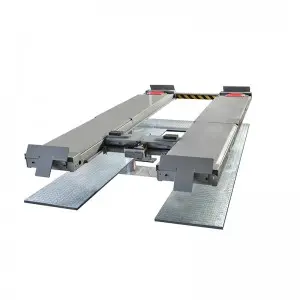****
In the world of automotive service, efficiency and space management play crucial roles in the success of a repair facility. One of the most innovative solutions that have gained traction in recent years is the inground lift. This equipment not only optimizes available space but also enhances productivity by providing mechanics with an unobstructed work area. In this article, we will delve into the various benefits, installation considerations, and applications of inground lifts in automotive maintenance and repair facilities.
What is an Inground Lift?
An inground lift is a hydraulic or mechanical lifting system installed beneath the ground level, enabling vehicles to be raised for service without prominent above-ground structures. By eliminating the need for above-ground lifting equipment, inground lifts provide an unobstructed view of the vehicle and allow for easier access to various components, such as the undercarriage, transmission, and exhaust systems. This design is particularly appealing for shops that require a clean and organized workspace, as the lift disappears into the ground when not in use.
Benefits of Inground Lifts
1. **Space-Saving Design**

Exploring the Versatility and Benefits of Inground Lifts for Car Maintenance and Repair Facilities
One of the most significant advantages of inground lifts is their spatial efficiency. Traditional lifts can consume considerable vertical space, which may not be ideal for all facilities. In contrast, inground lifts occupy minimal overhead space, allowing for more efficient use of the shop area. This feature is especially beneficial in urban settings, where real estate costs can be exorbitant, and maximizing every square foot of the facility is vital.
2. **Enhanced Safety**
Safety is a core consideration in any automotive service facility. Inground lifts provide a safer working environment for mechanics and technicians. With their low-profile design and sturdy build, they minimize the risk of accidents associated with traditional above-ground lifts. These lifts also typically feature safety locking systems, which prevent the lift from falling or collapsing while in use. Thus, inground lifts contribute to a reduction in workplace injuries.
3. **Ease of Use and Access**

Exploring the Versatility and Benefits of Inground Lifts for Car Maintenance and Repair Facilities

Exploring the Versatility and Benefits of Inground Lifts for Car Maintenance and Repair Facilities
Using an inground lift is a straightforward process. Once the vehicle is driven onto the lift, it can be raised easily with the push of a button. The low profile of inground lifts offers mechanics clear access to the vehicle’s underside without obstruction. This direct access streamlines repair and maintenance tasks, reducing the time necessary to complete jobs.
4. **Aesthetic Appeal**
For many repair shops, maintaining a professional and clean appearance is important, as it reflects the quality of service provided. Inground lifts, being out of sight when not in use, contribute to a sleeker and more organized shop design. This aesthetic improvement can positively impact customer perception and trust, leading to increased business opportunities.
Installation Considerations
While the benefits of inground lifts are compelling, there are essential factors to consider before installation. First, the initial investment for an inground lift can be higher than that of traditional lifts. This cost includes not only the equipment itself but also the excavation and construction required to install the lift properly.
Moreover, proper planning is essential to ensure that the lift meets required safety standards and is compatible with various vehicle types. Adequate space for the lift and any necessary hydraulic lines must also be evaluated before installation, as improper setup can lead to operational issues in the future.
Applications of Inground Lifts
Inground lifts are versatile tools that can be used in various automotive service applications. They are commonly used in general repair shops, tire dealerships, and inspection facilities. Their ability to accommodate multiple vehicle types, from passenger cars to heavy-duty trucks, significantly enhances their utility across different sectors of the automotive industry.
Additionally, some specialty shops, such as those focused on auto restoration or customization, benefit greatly from using an inground lift. The unobstructed access to the vehicle’s undercarriage enables detail-oriented work that is often essential in such projects.
Conclusion
In ground lifts represent a significant advancement in automotive service technology. Their space-saving design, enhanced safety features, ease of use, and aesthetic appeal make them a valuable asset for any repair facility. While the initial investment may be higher, the long-term benefits often outweigh these costs, leading to increased efficiency and potentially higher profits. As the automotive industry continues to evolve, inground lifts will undoubtedly play a crucial role in shaping the future of vehicle maintenance and repair.quick car jack lift



